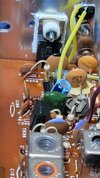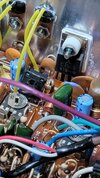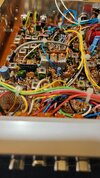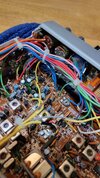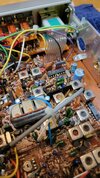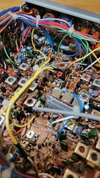you are very welcome.
congrats on the new radios.
be nice to them. the MB8719 PLL chip that is in those radios is VERY sought after and very hard to find. can you say expensive?!
i am a huge proponent of replacing all the electrolytics in these old radios, and you will find that they work AWESOME once you do it.
make sure you use 16 volt or higher caps. the ones rated at 10 volts never should have been used.
remember that the radio might need an alignment after you do this, as the values of the new caps will be a bit different than the old ones.
i wrote up a tutorial on how to align a 148GTL which is very close to the same as your grants.
you can find it by searching this forum.
not sure what i titled it though, sorry.
here are a few upgrades you should do when you are replacing all the caps.
these are not "peak and tweak" mods that mess up the radio, they are parts upgrades that make it work better.
replace Q41 with a 2N6487 or an NTE152.
this is the AM power reg. and the stock ones are underrated for what they do.
replace the main filter cap (i think its C172) with a 2200uF or 3300uF 25 volt cap.
this will give the radio some better headroom during modulation peaks.
replace C18 with a 680-1000uF cap.
this filters the mic line better and keeps the radio from squealing if you turn up the audio.
you can speed up the AMC attack time by replacing C109 with a 3.3uF cap.
replace C181 with a 1000uF cap. better filtering for the power supply.
the 2SC2999 receive mod works great in this chassis, and i highly recommend it.
you can buy the kits on ebay pretty cheap, as the 2999 can be hard to find on your own.
the diodes used are shottky barrier diodes. 1n6263 or NTE583.
replace Q14 with the 2SC2999 and replace D1, D2, D21, and D22 with the shottky diodes.
they are the AM detector and the noise blanker diodes.
there are many more mods for this chassis, and ive probably tried them all.
most of the modulation mods are actually worse than the radio is stock.
after trying all the mods, i now run my base station stock with a D104 silver eagle and it sounds great.
in the mobile i will remove R131 which disables the AM limiter but leaves the SSB circuits alone.
never remove or modify TR24 as it will cause SSB distortion.
changing R124 and 126 like all the google mods say will just make the radio want to squeal and make the audio sound muffled.
good luck with those radios and feel free to PM me if you have specific questions.
can you tell i love these radios? LOL
LC
oh, and i drink Sierra Nevada IPA. LOL



